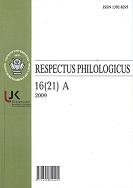PERIFERINĖS RAMAŠKONIŲ ŠNEKTOS ā, įā KAMIENŲ DAIKTAVARDŽIŲ LINKSNIAVIMAS
DECLENSION OF THE ā- and įā STEM NOUNS IN THE PERIPHERAL RAMAŠKONYS SUBDIALECT
Author(s): Nijolė TuomienėSubject(s): Language and Literature Studies
Published by: Vilniaus Universiteto Leidykla
Keywords: peripheral spoken; noun strains; parsing parsing; strain productivity and stability;
Summary/Abstract: The current article presents a study of a peripheral subdialect of Lithuanian, the Ramaškonys subdialect, which continues the South High Lithuanian subdialect in Varanavas district of Belarus. Owing to a number of sociolinguistic factors, such as over a hundred-year-old bilingualism (and multilin¬gualism), the decreasing status of the Lithuanian language, acceptance of the dominating Belarusian tongue, and the impact of Standard Lithuanian, whose importance for the subdialect remains unchanged, the Ramaškonys subdialect has been retreating from usage. The subdialect has no con¬tinuation since the tradition of inheriting it from generation to generation has been lost. The study reported here involves a thorough synchronic analysis of the declension of the ā, įā stem nouns in the present-day Ramaškonys subdialect. It also includes a comparison of two feminine declension paradigms characteristic of the two surviving generations of speakers. Their language is analysed in its recent status, namely, the language of representatives of the two generations over the last decade is being compared. The study showed that even under the circum¬stances of total isolation from the main territory of South High Lithuanian and regardless of the constantly decreasing number of speakers, the Ramaškonys subdialect has retained its systematic¬ity. The subdialect still possesses part of its specific vocabulary and many old forms. Thus the linguistic consistency of the subdialect does not seem to reflect its sociolinguistic dispersion. The declension of nouns bears traces of changes which are similar to those occurring in the subdialects of the main language area and Stand¬ard Lithuanian. The system of noun declension is gradually developing towards a two-type, namely, masculine and feminine, declension. Although the subdialect still has preserved nouns of the mixed declension type, the tendency of their polarization by gender is very prominent. The ā, įā stems are very productive and stable – they retain the paradigm structure and do not acquire additional inflexion classes or such classes are weakly represented. The įā stem of the oxytonic stress is stable but rather unproductive. The inves¬tigated stems have undergone many more phonetic rather than morphological changes.
Journal: Respectus Philologicus
- Issue Year: 2009
- Issue No: 16 (21) A
- Page Range: 188-201
- Page Count: 14
- Language: Lithuanian

